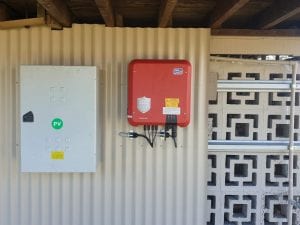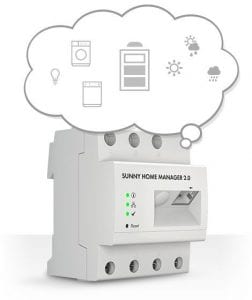Who are they?

SMA were founded in Hesse, Germany, in 1981 (ok, so almost 40). Since then they’ve done one thing and one thing only – solar inverters. Because of this, they’ve got very good at it, and in 2018 had sales in excess of €750m – all from solar inverters. As of 2020 they have over 3000 employees, with offices in 18 countries; they’ve installed over 75GW of inverter capacity worldwide (equivalent to 250~300 million solar panels); and have over 750,000 inverters installed in Australia alone.
SMA have a head office in Sydney.
What do they do?
If you have a small shed in the middle of nowhere, or a solar farm with thousands of panels, SMA has a solution for you.
Their basic model is the Sunny Boy. In sizes from 1.5kW to 6.0kW, this is your residential, single-phase inverter. Unlike most inverters, which are grey/silver, the SB is red! Going up in size (and phases), you have the Sunny Tripower. This is the three-phase offering, from 3.0kW all the way up to 25kW. These come in a lovely blue colour. Bigger than that is the Tripower CORE1, a 50kW string inverter, then the 75kW Highpower PEAK1, and the 150kW Highpower PEAK3 – although sadly these are all silver.

Another thing SMA are well-known for are off-grid installations – that is, remote places that the mains grid hasn’t reached. Because they have no guaranteed supply, off-grid installations make extra use of batteries and generators – and this makes them more complex to design and install. Their hybrid (battery-charging) inverter is called the Sunny Island, or Sunny Boy Storage.
The main off-grid brands are Selectronic, Victron, and SMA. Selectronic and Victron only do off-grid solutions, and while they make excellent products, they do require specialists – whereas SMA is the bigger, more well-known – and better-supported – brand, meaning for grid-connected battery or smaller/simpler off-grid setups, SMA may be the best option.
Monitoring
The standard case applies with SMA; the inverters have built-in production monitoring that can connect to your Wi-Fi, and with the purchase of an energy meter you can also monitor your energy consumption and how much energy you import from and export to the grid.
If you want further control you can get the SMA Home Manager. This can monitor individual appliances – such as your washing machine or your refrigerator – and work out exactly how much of your energy is used by each device. This lets you take further actions to reduce your energy usage – in fact, the Home Manager uses smart technology (including weather forecasts and self-learning) to automatically control your appliances to optimise your energy balance. As they say, knowledge is power – or, in this case, power savings.

They also have devices for controlling multiple inverters, especially useful for commercial installs with several PV systems. I won’t go into detail about these here; more information can be found on the SMA website.
Warranty
SMA inverters come with 5-year manufacturer’s warranty. You can upgrade this to 10, 15, or 20 years for $200~$5200 (depending on time and model). One good thing about SMA warranty is that if you make a warranty claim they will immediately dispatch a new unit for you to replace the faulty one – rather than having to first send the faulty one away, wait for them to fix it, and then have it returned. This means, if you do encounter an issue, the downtime of your system is minimised.
Conclusion
Not many companies have been making solar inverters for four decades. With their German engineering, vast experience, and high levels of customer support, you can’t really go wrong with an SMA inverter – whether you’re on grid or off, with a battery or without, a small home or a huge company. Their smart energy management technology means you can make the most of your solar, and their warranty replacement scheme will mean any issues will cause very little lost generation.










